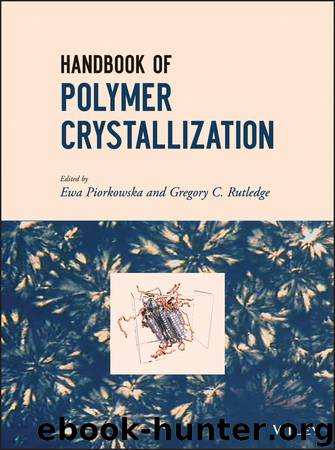Handbook of Polymer Crystallization by Ewa Piorkowska & Gregory C. Rutledge

Author:Ewa Piorkowska & Gregory C. Rutledge
Language: eng
Format: epub
Publisher: Wiley
Published: 2013-05-28T16:00:00+00:00
One other crystallographic face of αiPP has been observed to be involved in epitaxial crystallization. It is the structurally more complex (110) face. This face involves both right- and left-handed helices. The pattern of methyl side chains exposed in this face generates again a quasi-linear grating, tilted at 57° to the c-axis, with an inter-row distance of 0.55 nm. PTFE is most noteworthy among epitaxial substrates that match this 0.55-nm distance [34]. Another, more complex epitaxy with a high melting polyolefin will be discussed later (cf Section 8.4.2).
The β phase of iPP is obtained under normal crystallization conditions as a minor component compared with the α phase. Although the β phase is based on the same threefold helical conformation, it differs significantly from the α phase. The unit cell is trigonal and houses three isochiral helices. These helices have different azimuthal settings in the unit cell, which defines the structure as frustrated [35–37]. From a structural standpoint, the interchain distance and the chain axis repeat distances are nearly equal (0.635 nm and 0.65 nm, respectively). Due to the different azimuthal settings, the methyl side chains do not create a regular, organized pattern, and only the chain axis repeat distance seems to be at play in epitaxial crystallization. Historically, the first substrate found to initiate the β phase is a pigment, γ-chinacridone [38], but many different nucleating agents have been patented, in view of the technological interest in this crystal modification (e.g., better impact strength than the more common α phase). Epitaxial crystallization of the β phase (cf Fig. 8.1) has helped solve its crystal structure and establish its frustrated character [39]. As a result of frustration, the azimuthal settings of the chains in the unit cell are different. Probing the topography of a crystal plane should therefore highlight some helices, but not all helices equally, in that face. Indeed, AFM imaging of the (110) plane of βiPP reveals more clearly the protruding methyl groups of one of the three helices and therefore its different azimuthal setting, which is a real space “signature” of frustration [39] (Fig. 8.5b, c.f. also Chapter 2).
Download
This site does not store any files on its server. We only index and link to content provided by other sites. Please contact the content providers to delete copyright contents if any and email us, we'll remove relevant links or contents immediately.
Whiskies Galore by Ian Buxton(41550)
Introduction to Aircraft Design (Cambridge Aerospace Series) by John P. Fielding(32900)
Small Unmanned Fixed-wing Aircraft Design by Andrew J. Keane Andras Sobester James P. Scanlan & András Sóbester & James P. Scanlan(32585)
Aircraft Design of WWII: A Sketchbook by Lockheed Aircraft Corporation(32141)
Craft Beer for the Homebrewer by Michael Agnew(17944)
Turbulence by E. J. Noyes(7725)
The Complete Stick Figure Physics Tutorials by Allen Sarah(7157)
The Institute by Stephen King(6812)
Kaplan MCAT General Chemistry Review by Kaplan(6623)
The Thirst by Nesbo Jo(6465)
Bad Blood by John Carreyrou(6289)
Modelling of Convective Heat and Mass Transfer in Rotating Flows by Igor V. Shevchuk(6237)
Learning SQL by Alan Beaulieu(6051)
Weapons of Math Destruction by Cathy O'Neil(5865)
Man-made Catastrophes and Risk Information Concealment by Dmitry Chernov & Didier Sornette(5682)
Permanent Record by Edward Snowden(5554)
Digital Minimalism by Cal Newport;(5410)
Life 3.0: Being Human in the Age of Artificial Intelligence by Tegmark Max(5207)
iGen by Jean M. Twenge(5181)
